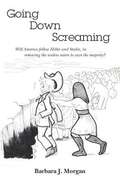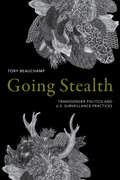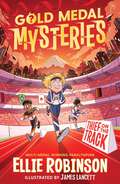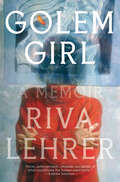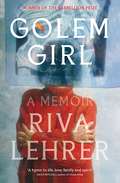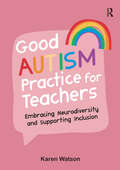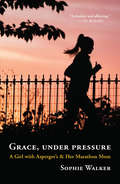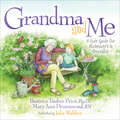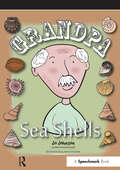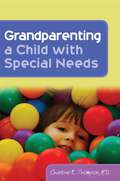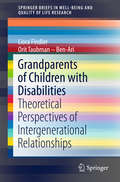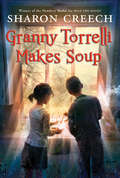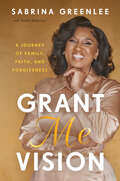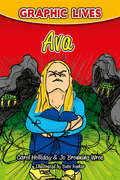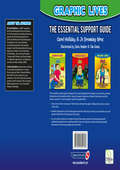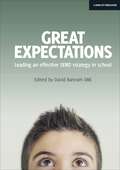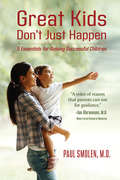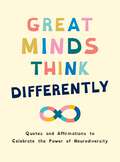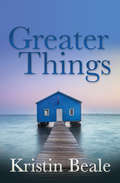- Table View
- List View
Going Down Screaming: Will America Follow Hitler and Stalin, In Removing the Useless Eaters To Save The Majority?
by Barbara J. MorganA history of the nursing home industry, coupled by a short history of the school system. There two events are the crux of the story describing the elderlly and their values, the young and their lack of values. Subsequently when the crises of America comes to fore, (too many seniors, too few young)the outcome of life for the elderly will be determined by the children of today. It can only end in euthanasia. The lack of sufficient young to pay the bills for the elderly was created by the abortion act in Roe vs Wade, which ironically enough is now working against those who agreed to the abortion law, and now are dependent on that low census generation to spare them.
Going Places Transition Scheme: Supporting Children with Additional Needs into Secondary School
by Carolyn Gelenter Nadine PrescottDesigned to support children with additional needs into their first year of secondary school in a safe and confident way, this resource provides all that is needed for schools to achieve a successful transition for all their children. The resource will give the students an opportunity to: become familiar with the layout of their new school; feel confident and safe about attending secondary school; become familiar with other students who will be attending their new school; and develop coping strategies to support their transition. Sessions include: Eating lunch, Secondary school lessons, Keeping safe and home-school links. Templates for timetables, games, charts, certificates and other resources are provided on the accompanying downloadable resources.
Going Stealth: Transgender Politics and U.S. Surveillance Practices
by Toby BeauchampIn Going Stealth Toby Beauchamp demonstrates how the enforcement of gender conformity is linked to state surveillance practices that identify threats based on racial, gender, national, and ableist categories of difference. Positioning surveillance as central to our understanding of transgender politics, Beauchamp examines a range of issues, from bathroom bills and TSA screening practices to Chelsea Manning's trial, to show how security practices extend into the everyday aspects of our gendered lives. He brings the fields of disability, science and technology, and surveillance studies into conversation with transgender studies to show how the scrutinizing of gender nonconformity is motivated less by explicit transgender identities than by the perceived threat that gender nonconformity poses to the U.S. racial and security state. Beauchamp uses instances of gender surveillance to demonstrate how disciplinary power attempts to produce conformist citizens and regulate difference through discourses of security. At the same time, he contends that greater visibility and recognition for gender nonconformity, while sometimes beneficial, might actually enable the surveillance state to more effectively track, measure, and control trans bodies and identities.
Gold Medal Mysteries: Thief on the Track (Gold Medal Mysteries)
by Ellie RobinsonJoin three sporting detectives as they race around the world in the brand new mystery adventure series from multi gold medal-winning Paralympian, Ellie Robinson. Hannah, Maria, and Seb are at the World Championships in Tokyo, bonding over their excitement at watching their favourite athletes compete. But Jesse Marks, a star runner on the US relay team has had his gold medal stolen! The sport park is alive with gossip and as the three new friends begin to investigate, several suspects begin to emerge. With time running out before the final race is run, can the detectives uncover who is out to sabotage the team? The race to solve the case is on in this twisting, action-packed look-behind-the-scenes at the world's biggest sporting event, with clues and illustrations throughout from James Lancett.
Goldie, The Story of a Guide Dog
by J. J. ProwseWhen Betty and Terry meet Mr. Write and his beautiful labrador Bella in the park, and learn about what a guide dog can do, they decide to donate their puppy Goldie to the Royal Guide Dogs Association in Australia. The following year, they raise Goldie to be a guide dog, and train Prince another pup. At the same time Dave Stewart a young man in their town, applies to get a guide dog after loosing his sight in a fire. Fate seems to be in the cards as he is matched with Goldie. This is the story of Goldie's training, her process of testing, puppy raising, training, and working with David, and Terry and Betty's love and experiences as puppy walkers.
Golem Girl: A Memoir
by Riva LehrerThe vividly told, gloriously illustrated memoir of an artist born with disabilities who searches for freedom and connection in a society afraid of strange bodies&“Golem Girl is luminous; a profound portrait of the artist as a young—and mature—woman; an unflinching social history of disability over the last six decades; and a hymn to life, love, family, and spirit.&”—David Mitchell, author of Cloud AtlasWhat do we sacrifice in the pursuit of normalcy? And what becomes possible when we embrace monstrosity? Can we envision a world that sees impossible creatures?In 1958, amongst the children born with spina bifida is Riva Lehrer. At the time, most such children are not expected to survive. Her parents and doctors are determined to "fix" her, sending the message over and over again that she is broken. That she will never have a job, a romantic relationship, or an independent life. Enduring countless medical interventions, Riva tries her best to be a good girl and a good patient in the quest to be cured.Everything changes when, as an adult, Riva is invited to join a group of artists, writers, and performers who are building Disability Culture. Their work is daring, edgy, funny, and dark—it rejects tropes that define disabled people as pathetic, frightening, or worthless. They insist that disability is an opportunity for creativity and resistance. Emboldened, Riva asks if she can paint their portraits—inventing an intimate and collaborative process that will transform the way she sees herself, others, and the world. Each portrait story begins to transform the myths she&’s been told her whole life about her body, her sexuality, and other measures of normal.Written with the vivid, cinematic prose of a visual artist, and the love and playfulness that defines all of Riva's work, Golem Girl is an extraordinary story of tenacity and creativity. With the author's magnificent portraits featured throughout, this memoir invites us to stretch ourselves toward a world where bodies flow between all possible forms of what it is to be human.Priase for Golem Girl&“Lehrer&’s story is a revelation of an inner subjective life—full of tragedy, love, and creativity—pushing against the external social stigmas, cultural narratives, and prejudices surrounding disability. She admits a felt kinship with other &“monsters&” because their bodies were also &“built by human hands,&” but unlike them, she is her own purpose, her own meaning, her own unstoppable golem.&”—Stephen Asma, author of On Monsters: An Unnatural History of Our Worst Fears
Golem Girl: A Memoir - 'A hymn to life, love, family, and spirit' DAVID MITCHELL
by Riva Lehrer'A hymn to life, love, family, and spirit' DAVID MITCHELL, author of Cloud AtlasThe vividly told, gloriously illustrated memoir of an artist born with disabilities who searches for freedom and connection in a society afraid of strange bodies.***WINNER OF THE BARBELLION PRIZE***In 1958, amongst the children born with spina bifida is Riva Lehrer. She endures endless medical procedures and is told she will never have a job, a romantic relationship or an independent life. But everything changes when as an adult Riva is invited to join a group of artists, writers, and performers who are building Disability Culture. Their work is daring, edgy, funny, and dark, and it rejects tropes that define disabled people as pathetic, frightening or worthless, instead insisting that disability is an opportunity for creativity and resistance. Riva begins to paint their portraits - and her art begins to transform the myths she's been told her whole life about her body, her sexuality, and other measures of normal.'A brilliant book, full of strangeness, beauty, and wonder' Audrey Niffenegger'Wonderful. An ode to art and the beauty of disability' Cerrie Burnell'Stunning' Alison Bechdel***SHORTLISTED FOR THE NATIONAL BOOK CRITICS CIRCLE AWARD***
Good Autism Practice for Teachers: Embracing Neurodiversity and Supporting Inclusion
by Karen WatsonFind out more about inclusive teaching with Good Autism Practice for Teachers, a well-regarded guide that equips educators with practical, evidence-informed strategies to support neurodivergent learners. Whether you're a seasoned teacher or a trainee, including SENCOs, this book is your key to transforming your classroom.Explore the theory around autism, delving into topics such as; procedural /semantic memory, executive functioning, expressive/receptive language, sensory integration, behaviour as communication, and the importance of emotional literacy, co-regulation and resilience. Packed with plenty of actionable advice you can incorporate into your everyday teaching, and high-quality strategies designed to foster positive relationships, enhance teaching and optimise learning outcomes.Good Autism Practice for Teachers isn't about prescribing one-size-fits-all solutions; it's about empowering you to make informed decisions tailored to your unique class and students.
Goodbye Hamilton
by Catherine CooksonA continuation of Maisie's story, and she still feels the need for her imaginary horse Hamilton. Her deformed arm makes it hard for her to defend herself, and it seems that she is destined to have sorrow with a small amount of happiness.
Grace, Under Pressure
by Sophie WalkerWhen Sophie Walker's daughter Grace was diagnosed with Asperger Syndrome, her world unravelled. Her high-powered job was in disarray, she couldn't sleep, often woke in tears and felt hopeless and useless in her role as a mother. One day she realized she hadn't done any exercise for months, and had been neglecting her physical health as well as her mental wellbeing. Previously a keen runner, she set herself the challenge of running the London Marathon to raise awareness of Asperger Syndrome and make herself physically strong enough to care for her demanding daughter. Invigorated by the physical challenge she had set herself, Sophie began a blog - 'Grace Under Pressure' - writing about both day-to-day life bringing up Grace alongside training for the marathon. The combination caught the imagination of readers and the blog took off, garnering praise from a wide range of sources. Now transformed into a book, GRACE UNDER PRESSURE is a moving story that charts the highs and lows of raising a child with Asperger Syndrome and the physical challenge of training for a long-distance running event.
Grandma and Me: A Kid's Guide for Alzheimer's & Dementia
by Mary Ann Drummond Beatrice Tauber PriorA beautiful storybook that helps children understand their grandparent&’s challenges, written by a nurse and a psychologist. The authors of Grandma and Me have combined their years of clinical experience to create a truly engaging, yet informative book for young children on the topics of Alzheimer&’s and dementia. With beautiful artwork to capture children&’s attention, Grandma and Me provides a gentle, age-appropriate portrait of Alzheimer&’s disease in the context of a loving relationship between grandparent and grandchild—and provides tools that will help children continue to have a relationship with their loved one despite the disease. Grandma and Me addresses a difficult topic with compassion and understanding, and allows families to successfully navigate the journey ahead.
Grandpa Seashells
by Jo Johnson'Grandpa Sea Shells' tells the story of three young children who spend a day with their grandparents after their grandfather has been diagnosed with dementia. The book is intended to support conversation at the time of first changes in a relative, a diagnosis of dementia and mild to moderate progression. Families and clinicians have told us this is the time period when they need material to support their explanations to children. Whilst the book could be used to start a conversation about any form of dementia, most of the key symptoms described in this story reflect the typical features associated with the Alzheimer's type, as this continues to be the most common. This book has been designed so that children of between four and ten can read it independently. Ideally it should be used with an adult to facilitate discussion about all aspects of family life and to enhance general emotional wellbeing. The book deliberately makes dementia one of many things going on for this family and highlights things that families can still enjoy together. We have included ideas for positive activities at the end of the book as well as puzzle and description pages that children can enjoy doing with a family member, teacher or clinician.
Grandparenting a Child with Special Needs
by Charlotte ThompsonWhen a new baby is born into a family, grandparents are excited about having a baby to enjoy and love. If the child is born with a disability, it can be difficult to know how to react and how best to help the child and the family as a whole. This book provides guidance on how to grandparent a child with special needs and give every grandchild the love and care they deserve and parents the added support they need. From coming to terms with a diagnosis, to helping with the transition from adolescence to adulthood, the book gives clear advice on grandparenting a child with special needs throughout their life. The author covers the medical, emotional and practical aspects of being a grandparent and explores important issues such as researching resources for specialized care, accessing financial and legal resources and, just as importantly, how to have fun and spend quality time with a grandchild with a disability. The book also addresses how to handle the diagnosis of a serious accident or progressive illness. Grandparenting a Child with Special Needs is a unique guide for grandparents keen to make a difference to the lives of their children and their grandchildren.
Grandparents of Children with Disabilities
by Liora Findler Orit Taubman – Ben-AriThis briefs offers a comprehensive view of the journey of grandparents of children with disabilities by employing a wide range of theoretical approaches such as intergenerational relationships, positive psychology, psychoanalytic views and models of stress. It presents a multidimensional view of grandparents, which begins with the general role of grandparents in the family and the transition to grandparenthood, as a major life event. The briefs moves on to discuss grandparents' roles under unique circumstances such as illness or disability in the family and then deals with perspectives of parents of children with disabilities on the role of grandparents. Finally, it reviews attitudes of professionals toward grandparents and concludes with suggested intervention strategies for working with families on intergenerational relationships.
Granny Torrelli Makes Soup
by Sharon Creech<P>Bailey, who is usually so nice, Bailey, my neighbor, my friend, my buddy, my pal for my whole life, knowing me better than anybody, that Bailey, that Bailey I am so mad at right now, that Bailey, I hate him today. <P>Twelve-year-old Rosie and her best friend, Bailey, don't always get along, that's true. But Granny Torrelli seems to know just how to make things right again with her warm words and family recipes. She understands from experience that life's twists and turns can't rattle the unique bond between two lifelong pals. <P>Newbery Medal winner Sharon Creech cooks up a delightfully tender novel, filled with homemade dishes and secret recipes. It's easy to remember what's important about love, life, and friendship while Granny Torrelli makes soup.
Grant Me Vision: A Journey of Family, Faith, and Forgiveness
by Sabrina GreenleeForeword by DeAndre HopkinsIn this extraordinary memoir, Sabrina Greenlee, the indomitable mother of NFL sensation DeAndre Hopkins, unveils her journey of triumph over adversity—a saga of tenacity, redemption, faith, and the profound reclamation of personal power.Sabrina Greenlee was born to teenage parents in the shadow of South Carolina’s Clemson University, and her story unfolds against the backdrop of her challenging upbringing in a family that lacked the means—financial and emotional—to offer her and her two brothers the safety, comfort, and love every child deserves. When she was a teenager, her beloved younger brother, Dilly, died in a drunk driving accident. In her early twenties, Sabrina faced the tragic loss of her fiancé and one true love. A decade later, she was brutally and publicly assaulted, resulting in the loss of her vision. After years of abusive relationships, Sabrina willed herself to achieve the kind of life she had always dreamed of. She became the loving and dependable mother she wished she’d had, raising four children— including star athletes—who attended college and are successful in their chosen fields. She also found the courage to break the silence that enshrouded her life, ending the trauma that had damaged her family for generations—allowing Sabrina and her kin to heal. Today she works to help other women assert their power and find the faith to have strength even when the future seems hopeless—just as she herself has. Grant Me Vision is her riveting story—a memoir of resilience in the face of life’s most difficult challenges. It serves as a testament to faith and fortitude, encouraging others to confront their past and to make peace with it.
Graphic Lives: A Graphic Novel for Young Adults Dealing with an Eating Disorder (Graphic Lives)
by Carol Holliday Jo Browning Wroe Angeleen RenkerGraphic Lives is a series of highly engaging graphic novels for young people who may need counselling and psychotherapy. Each book introduces the difficulties faced by a teenage character and follows them as they travel on their therapeutic journey with a skilled and creative therapist. The key aims of these books are: to demystify counselling and psychotherapy so that it is more appealing and accessible to young people; to destigmatise emotional and mental health problems so that young people are better able to accept help; to encourage young people to embark upon their own healing journeys, equipped with the sense that there is a way forward. Sixteen year-olds Ava and Jade are obsessed with food, calories, and staying thin. Pleased with the many compliments they receive they push themselves into anorexia. Ava's mother is alarmed by her daughter's weight loss and forces her into therapy with the school counsellor, Steph. However after only two sessions Steph touches a raw nerve, Ava storms out and refuses to continue. Only when Jade is admitted to hospital does Ava return to therapy, where she begins to understand the causes of her anorexic tendencies.
Graphic Lives: Essential Support Guide (Graphic Lives)
by Carol Holliday Jo Browning WroeGraphic Lives is a series of highly engaging graphic novels for young people who may need counselling and psychotherapy. Each book introduces the difficulties faced by a teenage character and follows them as they travel on their therapeutic journey with a skilled and creative therapist. The key aims of these books are: to demystify counselling and psychotherapy so that it is more appealing and accessible to young people; to destigmatise emotional and mental health problems so that young people are better able to accept help; to encourage young people to embark upon their own healing journeys, equipped with the sense that there is a way forward. The essential support guide, designed to be used alongside the Graphic Lives novels, provides therapists and counsellors with a range of support resources, linked to the stories and the issues covered. For each graphic novel, this guide offers: clear and concise coverage of risk factors and warning signs relating to the issue covered in the story; detailed exploration of each therapeutic session in the story so that you can devise you own sessions that link to the therapy in the story; an up-to-date summary of research around the issue covered in the book along with professional guidance on working with that issue to help you achieve the best possible outcomes for the young people you work with.
Gray Pancakes and Gold Horses
by Kenneth JerniganHow do blind children learn the details of the hundreds of small daily acts that sighted children pick up without ever even knowing they have done it? A blind boy sits in a farm house on a summer night and wonders which way to shake his head to mean yes and no. He guesses and loses, and his mother's feelings are hurt. I know, for I was that boy.
Great Expectations: Leading An Effective Send Strategy In School
by David BartramA selection of essays from leading educationalists and school leaders with a track record of improving outcomes for children and young people with additional needs, highlighting the significant role that school leaders play in shaping effective practice in SEND. Based on the SEND Review Guide, a national self-evaluation framework part-funded by the DfE and authored by David Bartram and Vijita Patel, downloaded by over 3000 schools, the book is divided into eight sections: Leadership; Teaching and Learning; Working with Pupils and Parents; Identification and Assessment; Monitoring and Tracking; Efficient Use of Resources; Developing Provision; Improving OutcomesEach section includes 3-4 essays. The opening essays offer a broad national perspective on the focus area, authored by a leading educationalist. The following essays, authored by school leaders from a range of educational settings including secondary, primary and special schools, highlight practical examples of how they have improved outcomes for this group of pupils, often in particularly challenging contexts. There will be a strong focus on impact of the approach.
Great Expectations: Leading An Effective Send Strategy In School
by David BartramA selection of essays from leading educationalists and school leaders with a track record of improving outcomes for children and young people with additional needs, highlighting the significant role that school leaders play in shaping effective practice in SEND. Based on the SEND Review Guide, a national self-evaluation framework part-funded by the DfE and authored by David Bartram and Vijita Patel, downloaded by over 3000 schools, the book is divided into eight sections: Leadership; Teaching and Learning; Working with Pupils and Parents; Identification and Assessment; Monitoring and Tracking; Efficient Use of Resources; Developing Provision; Improving OutcomesEach section includes 3-4 essays. The opening essays offer a broad national perspective on the focus area, authored by a leading educationalist. The following essays, authored by school leaders from a range of educational settings including secondary, primary and special schools, highlight practical examples of how they have improved outcomes for this group of pupils, often in particularly challenging contexts. There will be a strong focus on impact of the approach.
Great Kids Don’t Just Happen: 5 Essentials for Raising Successful Children
by Paul SmolenGreat Kids Don’t Just HappenIf there are children in your life, you need Dr. Smolen’s research and wisdom!Physically and emotionally healthy children are Great Kids. They are happier when young and thrive as adults.Pediatrician Dr. Paul Smolen identifies five essential parenting elements which help develop happy and successful kids.In Great Kids Don’t Just Happen you will learn how to use those elements and nurture the children in your life.The author’s observations and advice are supported by scientific studies referenced throughout the book and personal observations from his many years of practice as a pediatrician. The five essential elements and how to apply them are made easy to understand in the warm words of one who knows, practices, and teaches from research, observation, and experience.Learn how to provide:•Realistic praise•Consistent limits•A healthy emotional environment•Strong parental commitment•StabilityDr. Smolen’s research and wisdom are sure to be of great help for your family and loved ones.
Great Minds Think Differently: A Celebration of Those with ADHD, Autism, Dyslexia and Other Neurodivergent Conditions
by Summersdale PublishersEmbrace your own unique brilliance and find the confidence to make your mark on the world with this little book of positive words. Whether you have ADHD, autism, dyslexia or any other neurodivergence, Great Minds Think Differently is here to help you celebrate your gift and unleash the power of your mind.
Greater Things: Triumph Over Adversity
by Kristin BealeA true story of disability and determination: &“From flat-line to sunshine, this story takes you on an unbelievably heart-crossing journey.&” —Scott Pettit, Double Take At age fourteen, Kristin Beale was enjoying a happy summer vacation when a Jet-Ski accident turned her life upside-down—and nearly ended it. Ever since then, she has had to struggle to overcome not only the physical but the psychological toll of her injuries—and her grit and courage have been an inspiration to countless people. In Greater Things, Kristin offers a raw perspective on everything from how people react to her, to learning how to navigate in and through an inaccessible world, to just trying to make the best of a crummy situation. Filled with honesty, humor, and hope, it&’s a realistic yet ultimately uplifting portrait of what it takes to endure hardship with your spirit intact.
Greff: The Story of a Guide Dog
by Patricia CurtisGreff, a big yellow Labrador retriever, was destined to be a guide dog. Follow Greff from the night of his birth, through his experiences with his puppy raisers, to the time he returns to the Guide Dog Foundation for training, and to the day that Greff and his new owner graduate and go home.
